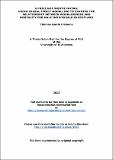Files in this item
A price not worth paying : using causal effect modelling to examine the relationship between worklessness and mortality for male individuals in Scotland
Item metadata
| dc.contributor.advisor | Dibben, Chris | |
| dc.contributor.author | Clemens, Thomas Laurie | |
| dc.coverage.spatial | viii, 194 | en_US |
| dc.date.accessioned | 2013-09-04T10:52:05Z | |
| dc.date.available | 2013-09-04T10:52:05Z | |
| dc.date.issued | 2012 | |
| dc.identifier.uri | https://hdl.handle.net/10023/4036 | |
| dc.description.abstract | The research conducted in this thesis examines the relationship between forms of worklessness (both active unemployment and inactivity due to sickness and disability) and mortality for working age men. Previous research has shown that being out of work is associated with a greater risk of mortality relative to being in work. However, there remains debate as to whether this association is the result of a causal pathway leading from worklessness to mortality or whether it reflects the ‘selection’ of individuals who are already at greater risk of mortality from pre-existing poor health or other characteristics. In the UK, many studies rely on the use of ‘wear-off’ periods in which mortality events occurring within five years after the observation of employment status are ignored to allow the confounding effects of selection to diminish. Generally these studies concluded in support of a causal relationship. In contrast, more recent studies making use of innovative methodological designs such as natural experiments and linked register and health datasets have found less evidence for this explanation with many emphasising the role of confounding and selection. The thesis aims to firstly, examine the effectiveness of wear-off periods and secondly, to develop an alternative counterfactual approach to examine the relationship between worklessness (both active unemployment and health related inactivity) and mortality. These questions are addressed in three stand-alone papers. In the first paper, data from the Scottish Longitudinal Study and the England & Wales Longitudinal Study was used in logistic regression models which estimated the odds of death in a given time period after the 1991 Census for those aged 35–64 in 1991. The odds ratios for the different economic positions (in work, unemployed, retired, permanently sick and other inactive) were compared, as well as the changes in risk associated with cumulatively increasing the length of wear-off prior to follow-up. No evidence was found of health related selection for the unemployed in 1991 suggesting that the use of the five year wear-off period in many studies of mortality and unemployment may be an ineffective and unnecessary technique for mitigating the effects of health-related selection. The second paper examined men aged between 35 and 54 who were in work in 1991. Subsequent employment status in 2001 was observed (in work or unemployed) and the relative all-cause mortality risk of unemployment between 2001 and 2007 was estimated. To account for potential selection into unemployment of those in poor health, a counterfactual propensity score matching framework was used to construct unbiased and comparable samples of in work and unemployed individuals. Matching was based on a wide range of explanatory variables including health status prior to year of unemployment (hospital admissions and self-reported limiting long term illness) as well as measures of socio-economic position. The findings showed that unemployment was associated with a doubling (hazard ratio 2.1 95% CI 1.30 - 3.38) of the subsequent risk of mortality from all causes relative to employment. This scale of effect was consistent across different samples and was robust controlling for prior health and socio-demographic characteristics. These findings were interpreted as evidence that the often observed association between unemployment and mortality may contain a causal component. The second paper implemented a similar analytical design to address the lack of evidence for the independent mortality effect of inactivity due to sickness. The results showed that the mortality risk of economic inactivity due to sickness relative to active employment was significant (HR. 3.18, 95% CI 2.53-3.98) and suggest that economic inactivity due to sickness poses a mortality risk that is independent of prior health. The findings could be interpreted in two ways; either economic inactivity due to sickness is worse for health than actively seeking work or previous studies of unemployment and mortality have underestimated the true effect of being out of work generally. Across the three studies, the main contribution of the thesis is to reassert the importance of worklessness as a determinant of individual mortality. In doing so the studies also found little evidence of systematic confounding by either health or other characteristics. The thesis concludes with a comprehensive discussion of the wider implications of the findings in relation to both general methodological issues in observational epidemiology and possible policy interventions that could be implemented to tackle work-related inequalities in male mortality. | en_US |
| dc.language.iso | en | en_US |
| dc.publisher | University of St Andrews | |
| dc.subject.lcc | HB1323.P82S3C6 | |
| dc.subject.lcsh | Unemployed--Mortality--Scotland | en_US |
| dc.subject.lcsh | Men--Mortality--Scotland | en_US |
| dc.subject.lcsh | Logistic regression analysis | en_US |
| dc.title | A price not worth paying : using causal effect modelling to examine the relationship between worklessness and mortality for male individuals in Scotland | en_US |
| dc.type | Thesis | en_US |
| dc.type.qualificationlevel | Doctoral | en_US |
| dc.type.qualificationname | PhD Doctor of Philosophy | en_US |
| dc.publisher.institution | The University of St Andrews | en_US |
This item appears in the following Collection(s)
Items in the St Andrews Research Repository are protected by copyright, with all rights reserved, unless otherwise indicated.

